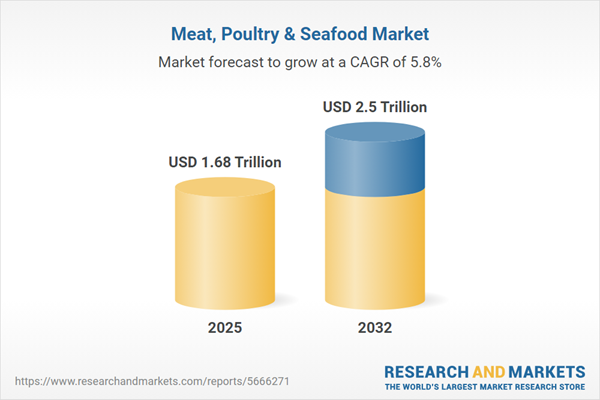Speak directly to the analyst to clarify any post sales queries you may have.
Senior executives overseeing the meat, poultry, and seafood market are guiding their organizations through a landscape marked by rapid digital transformation, regulatory shifts, and changing buyer demands. Success now depends on adopting forward-looking strategies that ensure agility, compliance, and operational innovation.
Meat, Poultry & Seafood Market Snapshot
The global meat, poultry, and seafood market is experiencing significant changes as companies integrate advanced technologies into core operations and update procurement practices. Investment in digital infrastructure has improved response times to evolving customer preferences, making operations more flexible and customer-centric. Modern omnichannel distribution permits companies to reach both business clients and consumers efficiently, while new compliance frameworks respond to heightened regulatory and transparency requirements. Organizations are now building adaptable business models to achieve both efficiency and rapid market responsiveness in a fluctuating competitive environment.
Scope & Segmentation: Drivers Shaping the Meat, Poultry & Seafood Market
This report offers an executive-level analysis tailored to identify adjacent opportunities and highlight potential risks across the entire value chain. Segmentation and scope include:
- Source Types: Conventional, halal, kosher, and organic options address cultural, religious, and nutritional preferences across diverse global markets while aligning with region-specific regulations.
- Distribution Channels: Foodservice, direct online sales, e-commerce platforms, supermarkets, and traditional retail routes are utilized to widen market entry points and enable tailored outreach to various buyer segments.
- Application Areas: Household, healthcare, educational, and hospitality sectors each present unique procurement challenges requiring sector-specific solutions and flexible service models.
- Product Forms: Fresh, frozen, smoked, cured, ready-to-eat, and value-added products support differentiation strategies and expand competitive positioning.
- Protein Types: Beef, chicken, pork, and seafood—including specialty options such as minced meats, steaks, crustaceans, and mollusks—meet a range of dietary needs.
- Packaging Types: Bulk shipments, trays, cases, vacuum-sealed options, and modified atmosphere packaging contribute to cost control, extended shelf life, and sustainability initiatives.
- Regional Coverage: The Americas, Europe, Middle East & Africa, and Asia-Pacific offer different growth drivers, regulatory challenges, and competitive landscapes, necessitating distinct market-entry strategies and localization of operations.
- Enabling Technologies & Best Practices: Adoption of digital analytics, advanced traceability, and robust sustainability frameworks is prevalent, with industry leaders such as JBS S.A., Tyson Foods, Cargill, WH Group, and Charoen Pokphand Foods continually refining their operations to build long-term resilience.
Key Strategic Takeaways for Executive Leadership
- Strengthening regenerative supply chains increases stakeholder confidence and advances corporate sustainability goals.
- Applying blockchain, digital analytics, and automation results in greater transparency and enables organizations to adjust promptly to unpredictable supply or demand trends.
- Continuous improvement of animal welfare standards and antibiotic management enhances organizational reputation and long-term industry standing.
- Investments in omnichannel logistics expand distribution flexibility and aid efficient market entry into new commercial segments.
- Proactive diversification of suppliers and structured risk management approaches help reduce exposure to operational disruptions at the global level.
- Pursuing strategic alliances, mergers, or acquisitions allows for market consolidation and supports growth in response to sector evolution and competitive pressures.
Tariff Impact: Navigating Regulatory Change
The recent introduction of new U.S. tariffs compels procurement and supply chain leaders to reassess sourcing approaches in the meat, poultry, and seafood sectors. Expanding supplier networks and reinforcing compliance protocols become essential for maintaining resilience amid regulatory uncertainty. Adopting strong cost management and adaptive procurement structures enables uninterrupted operations and aligns business functions with complex market demands.
Methodology & Data Sources
This analysis integrates qualitative insights from executive interviews and structured roundtables with quantitative data, combining proprietary research with public sources to support C-suite decision-making in the evolving meat, poultry, and seafood market.
Why This Report Matters: Actionable Insights for Executives
- Provides a structured overview of current regulations, market dynamics, and effective supply chain models to inform strategic planning by executive leaders.
- Offers clear frameworks to enhance procurement processes and strengthen readiness for market changes or regulatory interventions.
- Equips organizations with the tools for resilient enterprise planning and continuous adaptation in a rapidly transforming sector.
Conclusion
This report empowers senior leaders to anticipate industry risks, advance sustainability measures, and steer their organizations through proactive change within a complex global market environment.
Additional Product Information:
- Purchase of this report includes 1 year online access with quarterly updates.
- This report can be updated on request. Please contact our Customer Experience team using the Ask a Question widget on our website.
Table of Contents
3. Executive Summary
4. Market Overview
7. Cumulative Impact of Artificial Intelligence 2025
Companies Mentioned
The companies profiled in this Meat, Poultry & Seafood market report include:- JBS S.A.
- Tyson Foods, Inc.
- Cargill, Incorporated
- WH Group Limited
- Charoen Pokphand Foods Public Company Limited
- Marfrig Global Foods S.A.
- BRF S.A.
- Hormel Foods Corporation
- Mowi ASA
- Thai Union Group Public Company Limited
Table Information
| Report Attribute | Details |
|---|---|
| No. of Pages | 183 |
| Published | October 2025 |
| Forecast Period | 2025 - 2032 |
| Estimated Market Value ( USD | $ 1.68 Trillion |
| Forecasted Market Value ( USD | $ 2.5 Trillion |
| Compound Annual Growth Rate | 5.7% |
| Regions Covered | Global |
| No. of Companies Mentioned | 11 |









